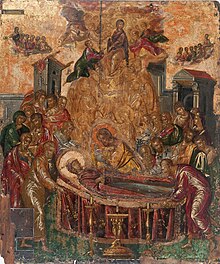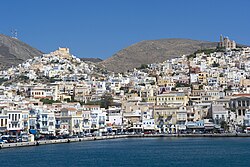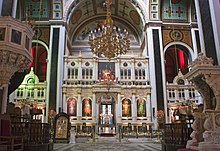Ermoupoli
|
Ermoupoli district Δημοτική Κοινότητα Ερμουπόλεως (Ερμούπολη) |
||
|---|---|---|
|
|
||
| Basic data | ||
| Country |
|
|
| region | South Aegean | |
| Regional district | Syros | |
| local community | Syros-Ermoupoli | |
| Geographic coordinates | 37 ° 27 ' N , 24 ° 57' E | |
| surface | 11.938 km² | |
| Residents | 11407 (2011) | |
| LAU-1 code no. | 58010101 | |
| Local division | 3 | |
| Post Code | 84100 | |
| Telephone code | 22810 | |
| Website: | www.hermoupolis.gr | |
The port city of Ermoupoli ( Greek Ερμούπολη ( f. Sg. ) Also obsolete Ermoupolis (Ερμούπολις)) is the economic and cultural center of the Cycladic island of Syros and the administrative seat of the municipality of Syros-Ermoupoli and the Greek region of the South Aegean . According to the 2011 census, the largest city in the Cyclades had 11,407 inhabitants.
The city was founded by refugees during the Greek Revolution after 1822, and received its name in 1826. Ermoupoli was the first commercial, shipping and industrial center in Greece.
location
Ermoupoli is located in the east of the island of Syros on the largest natural harbor bay. The city center is in the north of the bay, it extends to the Platia Miaouli ( Πλατεία Μιαούλη ) with the town hall. The business district is joined by residential areas, east along the coast Vaporia ( Βαπόρια ), up the hill to Ano Syros Vrondado ( Βροντάδο ). The industrial and commercial area with the Neorion shipyard is located in the middle of the harbor bay. The offshore islands Didymi and Strongylo are part of the municipality.
history
The founding of the city of Ermoupolis is a result of the neutral stance of the Cycladic island of Syros during the Greek Revolution . French and Austrian warships granted protection to the island, which is mostly inhabited by Catholics. After the devastation of Smyrna , Kydonies and the upstream Moschonisia in 1821, the massacre of Chios in 1822 and the destruction of Psara and Kasos in 1824, the island was the target of several waves of refugees. Before the waves of refugees in 1821, the place still had 150 inhabitants, but the first census in 1828 showed 13,805 inhabitants, and a further 6,392 inhabitants for the rest of the island. About a third of the newcomers came from Chios and a fifth from coastal towns in Asia Minor .
The economic, social and cultural backgrounds of the Greek Orthodox refugees, mainly traders and seafarers, were essential factors in the rapid rise of Ermoupoli to one of the most important cities in the newly founded Kingdom of Greece .
The development of the port city into the center of transit trade between the Eastern Mediterranean, the Black Sea and Western Europe in the following decades was based not only on the geographical location, but also on the trade and processing of textiles, leather and iron goods as well as an efficient banking system. Around 1860, Ermoupoli was the most important trading port in Greece. Two thirds of Greek imports were handled through the port. The economic boom in the last third of the 19th century was accompanied by a significant development of social and cultural life combined with brisk construction activity. Classicist buildings still shape the cityscape today and bear witness to the former prosperity. The most important buildings are the Apollon Theater by Pietro Sampo and the town hall by Ernst Ziller . In addition, around 800 town houses and 250 industrial buildings such as shipyards, forges, mills, paint factories, tanneries and spinning mills were built. The city became a magnet for immigrants from different parts of independent Greece in search of work and opportunities for social advancement. In 1879, Ermoupoli was the third largest city in Greece after Athens and Patras, with a population of 21,540 . With the advent of steam shipping and the opening of the Corinth Canal at the end of the 19th century, Ermoupoli lost its dominant position among the Greek ports to Piraeus .
- Population development of Ermoupoli
| Surname | 1821 | 1828 | 1861 | 1879 | 1920 | 1928 | 1940 | 1951 | 1961 | 1971 | 1981 | 1991 | 2001 | 2011 |
|---|---|---|---|---|---|---|---|---|---|---|---|---|---|---|
| Ermoupoli | 150 | 13,805 | 18,511 | 21,540 | 18,663 | 21,416 | 18,925 | 16,971 | 14,405 | 13,506 | 13,877 | 13,030 | 11,799 | 11,407 |
Attractions
Town Hall Square
In the northwest wing of the town hall (left hand) is the Archaeological Museum of the Cyclades. Among other things, exhibits from the time of the Keros-Syros culture can be admired here. Also excavations from the island itself, for example from the necropolis at Chalandriani ( Χαλανδριανή ) in the northeast of the island. But Byzantine exhibits are on display, as well as from other eras.
In front of the town hall is the "Miaoulis Square". The focus is on the statue of Andreas Miaoulis , which was erected on April 23, 1889.
On the right hand side is the former Lykeion Evangelidi (the building in which a Greek telecommunications provider is now located) . It was here that personalities such as Vikelas or Roidis once prepared for their studies and graduated from school.
A visit to the open-air cinema, on the left at Rathausplatz, Miaoulis Platz, can also be worthwhile. Most of the films (with the exception of children's films) are shown here in the original language with Greek subtitles.
Also very close to Miaouli Square is the historical archive of the Cyclades , "Megaro Ladopoulou", today also the city library with interesting editions.
Apollon Theater
The Apollon Theater is just a few meters from the town hall . Construction began in March 1862 before it was inaugurated on April 20, 1864 with the performance of Giuseppe Verdi's opera Rigoletto . The architect was the Italian Pietro Sambo. The construction is very reminiscent of that of the Milanese opera house “ Scala ”. On the ceiling there is a wreath with the faces of famous Italian and Greek composers. There is also a small museum in the stairwell.
In terms of culture, the theater is the center of Syros, where theater performances (opera, operetta, musical), concerts and the “Ermoupoli Festival” take place.
port
A statue of the goddess of victory Nike adorns the harbor promenade. It is intended to commemorate the fallen soldiers of the First World War.
During the day, Petros Protopapadakis Street (parallel street between Town Hall Square and the harbor) is a lively shopping street, while after the shops have closed, life mainly takes place in the street “Akti Ethnikis Antistasseos”. There are several taverns, bars and cafes that offer a beautiful view with their location directly on the harbor.
The former port facility is on the east side. Today the buildings are used for other purposes.
Churches
The church "Agios Nikolaos" is dedicated to St. Nicholas of Myra . It is in the north of the city. It was built from 1848 onwards. In 1870 it was opened. It is adorned by a clearly visible blue dome with gold decoration. It is one of the largest churches on the island and appears from the outside, with its entrance portal and the staircase, as one. Inside it is kept rather simple for Orthodox standards, but it looks all the bigger.
In front of the entrance area there is a memorial for the graveless fallen warriors of the island in a small garden.
The church is located in the “Vaporia” district, worth seeing especially because of its many neoclassical villas (streets: Bambagiotou, Apollonos, and Souri).
At the top of the “Vrontado” (mountain) is the orthodox church “Anastasis”, Church of the Resurrection, which is clearly visible from afar . Inside it has mostly neoclassical elements, as well as a wooden pulpit and icons , almost all from the 19th century.
From here you have a very nice view over Ermoupoli and up to Ano Syro. When the weather is good, the neighboring islands of Tinos and Mykonos are also visible.

Another Orthodox church worth seeing is the "Kimissi Theotokou" church, which opened in 1826. This houses namely the Dormition of the Mother of God from 1562 by Dominikos Theotokopoulos, also known under the name El Greco . This icon of the Mother of God also gave the church its name.
In contrast to the inside of the church, the outside with the bell tower is kept rather simple. In the evening it is easy to see from the harbor, as a blue glowing cross is attached to the bell tower.
The "Metamorfossi" (metamorphosis) is the most important Orthodox church on the island, as it is the Orthodox Episcopal Church of the island of Syros. It was completed in 1824. This baroque church has an inner courtyard with a mosaic and some unusual wood carvings and icons .
The only Roman Catholic church in Ermoupoli is the "Evangelistra", Church of the Annunciation of the Lord , from the beginning of the 19th century.
Others
There is also an industrial museum in Ermoupoli (opposite the hospital, in three former factory halls). Here you can marvel at over 300 exhibits from the heyday of the island's industry.
In the south of the city is the Demetrius Vikelas sports center. In the open-air water polo stadium, the Vikelas Cup takes place in summer with four junior teams from the national water polo teams of different nations.
In Ermoupoli there is also a cinema and a casino as well as a sports field .
Web links
Individual evidence
- ↑ Results of the 2011 census at the National Statistical Service of Greece (ΕΛ.ΣΤΑΤ) (Excel document, 2.6 MB)
- ↑ Christos Loukos: Families and family structure in a Neo-Hellenic city: Hermoupolis in the mid-19th century . In: The History of Family . No. 9 , 2004, p. 317-324 ( yorku.ca [PDF]).
- ↑ Alice Hatzopoulou, Joseph Stefanou, Stefanos Gerasimou: A system approach of the protection of traditional settlements: natural and cultural environment. In: Proceedings of the 10th Conference on Environmental Science and Technology. Kos 2007, pp. 492-496. On-line
- ↑ Population of Ermoupoli 1920–2011, Greek Statistical Office ELSTAT, Digital Library , Census 2011 (Greek)






